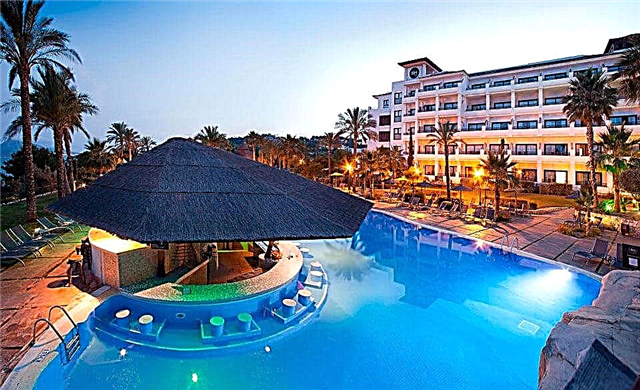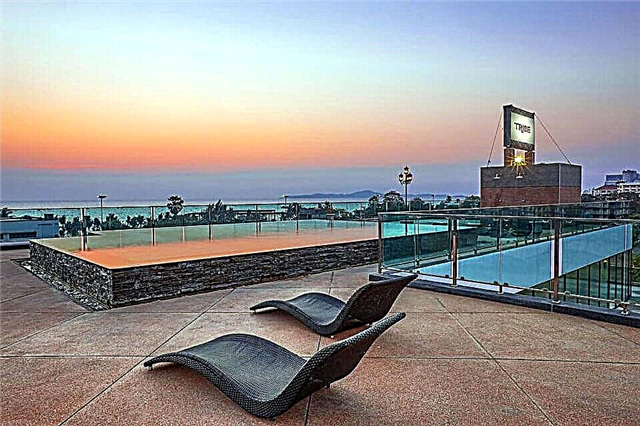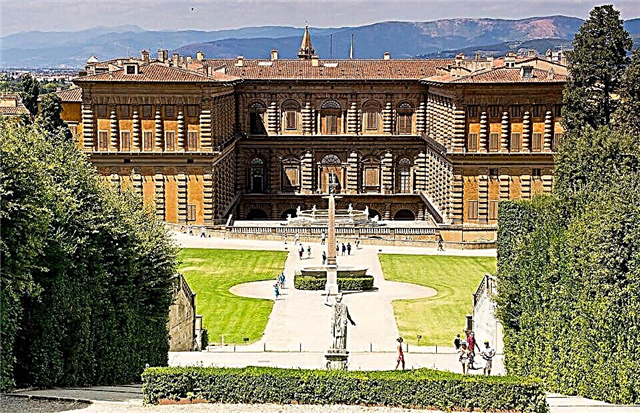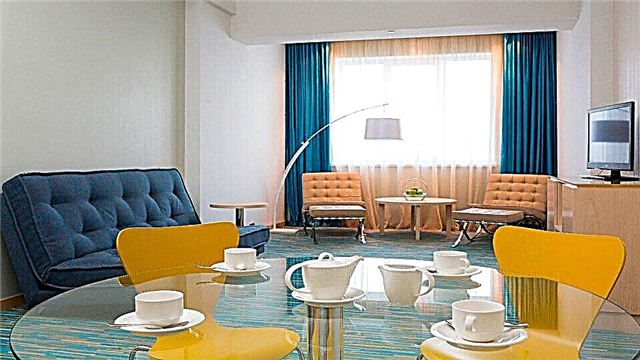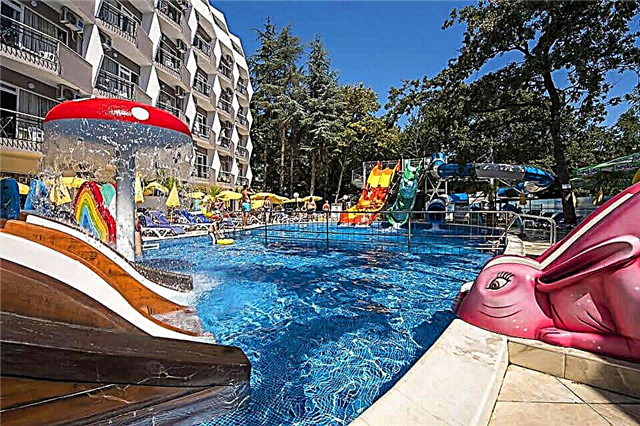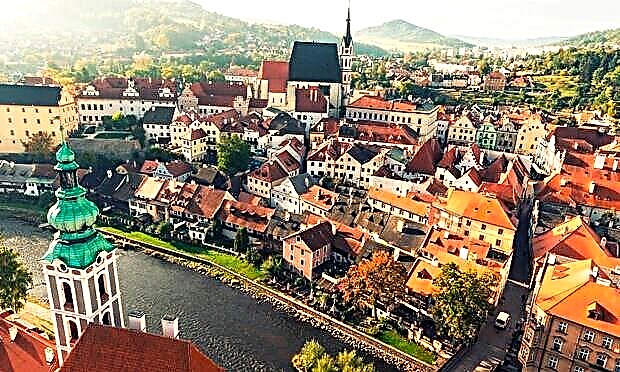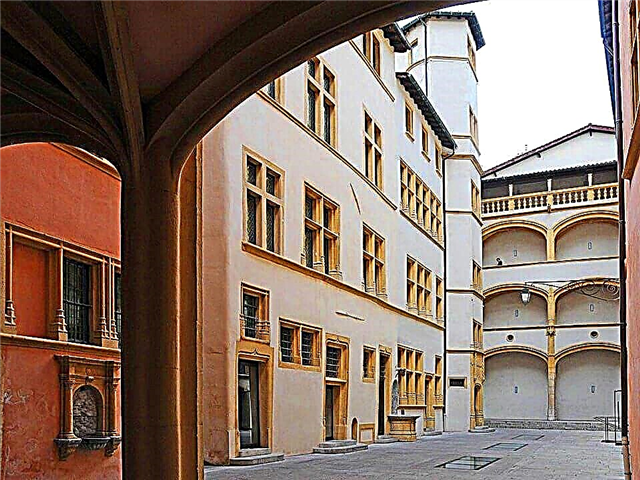The old French city is full of special charm, and tourists come here with pleasure. The sights of Lyon are numerous and admirable. There are old buildings and churches here, but there is also the Museum of Modern Art, which contains the world's largest collection of installations. Those who are interested in art will also visit the house where the Lumiere brothers lived and make sure that the cinema was born here. You can visit the performances in one of the Lyons theaters, or you can go to the wonderful zoo, where all the animals seem to be in their natural habitat. In a word, it will be interesting for both adults and the smallest. You can order a sightseeing tour, or get acquainted with the sights in advance with the help of books or the Internet, and decide for yourself what you most want to see.
Stock Exchange Palace

One of the most beautiful buildings, all tourists try to see it. It is located on the street of the Republic, and as if symbolizes the great importance that Lyon played in the life of France in the 19th century. Examining the building, guests remember the flourishing of the state and that tragic day when the President of the country was killed here. The decision to build a stock exchange was made in 1853. It was supposed to accommodate a museum, a chamber of commerce, and numerous shops and exchange agents in one building. A majestic building, similar to a palace, was erected in a short period of time - 4 years.
In 1856, the first stone was laid, and in 1860 - France celebrated the grand opening, which was visited by Emperor Napoleon C. The palace is 4 pavilions connected by a large luxurious hall, which was painted by local masters. The place where President Sadi Carnot fell, hit by a bullet, is also marked. It happened in 1894. This building previously housed a commercial court, a society that united silk merchants, a court for the protection of workers' rights, and a bank. Now the Chamber of Commerce and Industry is located here.
Bartholdi fountain

It is located in the Place des Terreaux. This fountain has long been a symbol of the city. It can be seen on postcards, calendars, magnets - in a word, on all souvenirs that tourists are so eager to buy. And the fountain is worth it. At one time, his project was presented by the young Frederic Bartholdi, who decided to participate in a competition held in Bordeaux in 1857. However, the construction of the fountain was not immediately started, the project was frozen. Everything changed in 1886, because it was Bartholdi who became the author of the Statue of Liberty, which to this day welcomes guests to New York.
Then the authorities of Bordeaux remembered the fountain, but it seemed to them "too expensive". The Lyon authorities did not share this opinion, and in 1892 the fountain was opened here. Those who come here today can also enjoy the spectacular lighting of the sculptural group. In the center is a woman who personifies France, she drives four horses - these are the main rivers of the country. Now the fountain is considered a historical monument, and the state is responsible for its preservation. The evening lights turn on at about 6 pm.
Selestine Theater

Just some kind of dollhouse. The theater, known all over the world, is built on Italian models and is no less popular than the Comedie Frances. It is already more than two hundred years old, and such popular actors as Sarah Bernhardt and Jean Marais, who gained fame even in Russia, played on its stage, and Napoleon Bonaparte can be considered the most famous spectator. Where does this strange name come from? From the monastic order. The theater is located where a monastery once stood on the banks of the Sona River.
The Celestine Society in the 18th century began building a theater and houses in its vicinity. Originally there was a variety show. However, severe fires that broke out from time to time at that time caused significant damage to the architecture. The flames did not spare this building either. The fire of 1871 practically destroyed the theater. But, perhaps, in a sense, it was for the better. After all, the small hall could no longer accommodate everyone who wanted to see the performance. And then Gaspard André won the competition for the best project.
A new theater was built and spectators were able to enter it already in 1877. However, another fire ended this building three years later. Andre had to restore it literally from the ruins. The last restoration took place at the beginning of the 21st century. In particular, the security system has been improved, in addition, much has been done for the convenience of the actors who are preparing for the performances. Nowadays performances in the theater are held regularly, the ticket price is quite reasonable. You can buy them both at the checkout and via the Internet. A quarter of an hour before the start of the performance, the so-called "last minute tickets" are sold at a symbolic price.
Amphitheater of the Three Gauls

In the place where the city is now located, the Romans lived in ancient times. They also erected the amphitheater of the three Gauls. These are the three provinces of the Roman Empire, whose lands were located on the territory of what is now France. A large amphitheater was built around 19 AD on the site of an ancient Gaulish settlement. Later, he "became famous" also for the fact that here the first Christian martyrs were given to be torn apart by lions.
According to legend, neither the fierce predators, nor the bulls that replaced them, touched Saint Blandina. In the end, the warriors killed her with swords. Now a monument to the martyr is erected on the territory of the amphitheater. The ancient theater makes a great impression, and many tourists always come here. The photographs are also extremely effective.
Basilica of Notre Dame de Fourvière

The basilica is located at the top of the Fourvière hill next to the metal tower. It was built at the end of the 19th century according to the project of Pierre Bossan, the temple was consecrated in honor of the Virgin, and the crypt - in honor of St. Joseph. It happened in 1896. Nearby you can see the chapel tower, left over from a medieval church - it was destroyed in the 16th century. Here Anna of Austria prayed, asking the Virgin Mary to grant her an heir. At the end of the 17th century, a plague raged here, the city authorities and residents prayed on the Fourvière hill for the "black death" to retreat as soon as possible.
And the epidemic began to decline. In the 19th century, the dilapidated chapel was dismantled and rebuilt. A statue of the Mother of God was also installed here. In 1870, moving from Paris, the Prussian army was advancing on these lands. And again, the inhabitants turned with prayer to the Virgin Mary, asking her to protect the city. Bismarck's army never took Lyon. After that, the basilica was built in honor of the Virgin. The final finishing was completed in the middle of the 20th century. The upper temple is especially richly decorated.
Metal tower on Fourviere

It was built after the success of the Eiffel Tower in Paris. In 1894, the city was supposed to host the World's Fair, it was assumed that it was by this time that the younger sister of the Eiffel Tower would appear here, on Fourvière Hill. The architect in this case was Mr. Colle. For some time it was even thought that the tower would be named Avelanova - in honor of the Russian admiral Avelan, but later this option was not considered by the authorities.
Today, there is a waiting room on the first floor of the tower, a restaurant on the second, and an observation deck at an altitude of over 350 m from the foot of the hill. All in all, the metal tower reaches 89 m in height. From here you can admire the Alps. During World War II, the invaders wanted to melt the tower, but in the end it survived. In 1953, it was acquired by the management of the French radio and television, now it plays the role of an antenna.
Antique theater on the Fourvière hill

Forms a single ensemble with odeon. Construction began in the days of Octavian Augustus. Then the arena appeared here, the diameter of which reached 90 m.The steps rose in a semicircle, two and a half dozen sectors spread out in the form of a fan. The elegant parterre was made of colored marble; there were semicircular niches on the stage.
For construction, stones were brought from the city of Glanum. A third floor was built in the 2nd century. The theater could accommodate up to 10 thousand spectators at the same time. Most often comedies were staged here, music sounded. Excellent acoustics made it possible to enjoy the performances. The performances took place during the warm season - the "season" began in the spring and ended in the fall. In the 19th century, the theater was found, in 1933 it was decided to restore it. Now the Fourviere Nights festival is held here every year.
Museum of Gallo-Roman Civilization

This museum is also located on the Fourvière hill, near the ancient theater. Archaeologists have established that a Roman settlement was located here. For the first time, the museum opened its doors to visitors in 1975, the building was designed by Bernard Serfus. He managed to fit his creation into the general landscape in such a way that it does not violate the overall impression. Many interesting finds have been collected at the site of the Roman settlement. There are statues, and jewelry worn by noble people, and clothes - ceremonial and household, various household items.
A model of the Lugdun settlement itself was also created, so that museum guests today have the opportunity to see how people lived here in antiquity. A very interesting mosaic depicts chariot races taking place in the circus. You can also see the ceremonial chariot made of bronze. Also, guests pay attention to the calendar, altar, sarcophagi. Silver items occupy a special place in the collection - the owners hid them in a cache around the 3rd century.
Rue Saint-Jean

The oldest part of the city lies at the foot of the Fourvière hill. The area of Vieux Lyon exceeds 420 hectares, and it includes several quarters. One of them is called Saint-Jean, once it was the political center of the city. The main street of the quarter is also called Saint-Jean. Today it is of great interest to tourists, as there are many historical sights here. The cathedral built in the Gothic style is amazing.
Every day, guests come to the Museum of Miniatures - in the 15th century, this building housed a tavern. The Manecanteri building is also interesting, which is a vivid example of the Romanesque style. And finally, no one leaves here without photographing the 17th century Pink Tower. There is a beautiful legend according to which the walls of the tower are painted with the blood of a young beauty who died from unhappy love. In fact, the walls were painted to match the tower in the movie The Three Musketeers.
Lyon Cathedral

This is a truly unique cathedral - and not only because of its architecture, but also because of the many historical events associated with it. Although many call it simply “Cathedral of Saint-Jean”, it must be remembered that it was consecrated in honor of John the Baptist. And add that this is the Cathedral of the Archbishop of Lyons. It houses an old astronomical clock from the 14th century, and in the "archaeological garden" you can see the ruins of 11th century churches and a 4th century baptistery. You can see the cathedral every day - it is open until the evening.
Only on the days of major holidays, tourists are allowed access only in the mornings. The construction of the cathedral began in the 12th century, on the site where an ancient church was once located. Among other building materials, workers used stones left over from destroyed Roman structures. The main façade was not completed until the end of the 15th century. Therefore, there is a mixture of styles in architecture - the part that was built first was in the Romanesque style, and the later in the Gothic style.
The decoration suffered from the Huguenots in the 16th century and from the most aggressive townspeople during the French Revolution. Only in the first half of the 20th century, the cathedral was restored in the form it had originally. At the end of the 20th century, renovations were carried out. It was here that the 13th and 14th Ecumenical Councils were held, and Pope John 22nd was crowned here. In this cathedral, Henry the 4th and Maria de Medici were married, and here the enthronement of Richelieu, who became a cardinal, took place.
Guests of the cathedral are advised to pay attention to the astronomical clock, which shows not only the exact time, but also the position of the Sun and the Moon, as well as the rise time of the brightest stars. They call four times a day, and the dolls associated with the clock “play out” whole plays. There is also a beautiful 19th century organ.
Town hall

National Historic Landmark, and the Town Hall played a big role in the life of the city. Previously, there was trade in the Place des Terreaux and, accordingly, it was dirty. When, in the 17th century, the town hall was erected on the square, it became the city's administrative center. However, soon after the completion of construction work, there was a severe fire, the building of the town hall had to be restored. This was done by the court architect Jules Hardouin-Mansart.
As a result, sculptures appeared on the facade - in particular, King Henry IV on horseback, as well as lovely women personifying the Sona and Rona rivers. However, after a few years, the building suffered from a fire so much that it needed restoration. The pride of the town hall is its bells - there are 65 of them. The inner courtyard is also very beautifully decorated. If you get inside the town hall, you will see an amazing painting of ceilings and walls, expensive furniture, luxurious stucco moldings.
Museum of Cinema Miniatures and Scenery

It was the French, the Lumiere brothers, who gave the world cinema. At first it was just moving pictures, replacing each other to the sounds of a piano, but now from the special effects that we see in films - the head is spinning. But to the Lumière brothers, humanity is still grateful. That is why there are always so many guests in the Museum of Miniatures and Cinema Decorations. It is not that big and you won't get tired of seeing the exhibits. But you will visit an amazing world.
The museum is located in an old mansion built in the 14th century. And such an unusual cultural center was founded by Dan Allman, who traveled a lot around the world and collected rare specimens for his collection. Allman was independently engaged in the manufacture of miniatures, brought the most interesting gizmos from the United States. Here you can see the legendary Schwarzenegger Terminator jacket as well as his weapon. The Indiana Jones hat is also kept here, as well as exhibits related to Star Wars.
A dozen of the museum's current staff are Allman's associates. The miniatures are simply mesmerizing. Historical interiors are recreated here in the smallest detail, visitors can see "from the inside" and famous theaters. Each such miniature has to work for about six months. The scenery for the film "Perfumer" is a real masterpiece. Adults can visit the exhibition dedicated to horror films. But impressionable children do not need to be brought here.
Fusion Museum

The museum, which has such an interesting name, stands where two rivers, the Rhone and Sona, converge. The architecture of the building is so unusual that it seems as if this project came from the future. And it was brought to life by Coop Himmelb (l) au, construction was completed in 2014. The museum is called differently. The company itself calls it "Crystal", while residents drew attention to a large hole in the center of the building and dubbed it "Hole". The area of the museum is huge - over 29 thousand m2.
Therefore, the "Crystal" can be seen from afar. The museum is divided into parts for temporary and permanent exhibitions. Also here will be held various scientific events - conferences, seminars. It will be possible to come here for a lecture, attend a meeting with a famous scientist. The main theme of the expositions is natural science. The exhibits will help to give an exact answer to the question - where did humanity come from.
Trinity Chapel

The chapel is located in the building of the Lyceum, which stands next to the Stock Exchange Palace. There are not very many tourists here.Those who are really interested in history and want to see the most interesting come here. In the 16th century, the role of the Order of the Jesuits increased in France, the Chapel was built in the 17th century, the architect gave it the features of the Baroque. The chapel opened in 1622 on the grounds of a Jesuit college. She immediately made a great impression on the townspeople. In 1802, Napoleon proclaimed the Italian Republic in this building. The college became the imperial lyceum, and the great physicist Andre-Marie Ampere lectured here.
The exquisite interiors of the church are decorated with marble. The wall panels were made by the famous sculptor Pierre David. The chandeliers, styled after the 17th century, give a special effect to the room. They appeared here at the end of the 20th century, and are almost like two drops of water similar to those that hung here before. Nowadays, various events are held in the chapel - exhibitions, concerts, festivals. The most famous of these is the annual Early Music Festival.
Gadan Museum

The Gadagne Museum is located in the Saint-Paul quarter. An interesting object that unites two cultural centers - the Historical Museum and the Puppet Museum. The building was surprisingly suitable for this purpose. It was built in the 16th century, the Hotel Gadan was located here, and it belonged to a wealthy family that bore this surname. When the Gadan brothers fell out, they actually divided the house - each took his own half, and began to lead his own way of life. Moreover, the building was divided so thoroughly that even going from one part to another was not easy.
Today you can see a picturesque courtyard here, and parts of the building are connected by galleries. In the Historical Museum, after restoration, you can see about 80 thousand exhibits that tell about the history of the city, starting from the Middle Ages. Examining the premises, one can imagine how rich people lived at that time. There is also a small Puppet Theater, where, in addition to performances, seminars are held. There is also a typical medieval garden in the building. In 1950, museum visitors were able to see a collection of puppets, and in the early 2000s, a separate museum was opened, occupying 9 exhibition halls. Here are puppets from all over the world.
House-Museum of the Lumiere brothers

The city can be proud that it was here that cinema was invented. True, the Lumière brothers did not think that they were creating a new direction of art. Auguste and Louis just made the first short film. It was called "The exit of workers from the factory of the Lumiere brothers." The public saw him in 1895. Shown in a Parisian cafe, the film made an unexpected profit for its creators. After that, the brothers shot several more short films.
They were documentary - no script, no sets, no artists. What the film would be about could be understood from the title - "Baby's Breakfast", "Arrival of the Train", etc. It is located on the territory of a factory owned by the brothers. The expositions tell about their life path. Nearby is the "Hangar of the First Film" - here you can watch old films, meetings with actors are periodically arranged.
Opera lyon

This is the third theater built on the same site. The first was built in the middle of the 18th century. It quickly became clear that it was too small for a large number of spectators who wanted to see the performances, and in 1826 it was demolished. A new building for 1200 people was erected in its place. Premieres of great operas took place here. For example, at the opening of the theater in 1831, the opera "The White Lady" was shown, "Boris Godunov" by Mussorgsky and other masterpieces were staged here.
In 1985, it was decided to practically rebuild the theater, keeping only some of the details from the previous building. Jean Nouvel was the architect of the project. Construction was completed by 1993. The new opera house has become much more spacious. Now the actors could prepare for the performances in the rehearsal rooms located in the underground part of the building. A glass dome appeared over the theater, where the ballet troupe was housed.
The height of the building exceeded 60 m, and the area was 80 thousand m2. On the facade you can see "traces of the past" - 8 sculptures of muses that adorned the former theater building. Despite the fact that the area of the theater has increased, there are no more seats for spectators. No more than 1100 people can watch the performance at the same time. If you have the opportunity to purchase tickets for an opera or ballet, be sure to take this chance.
St. Paul's Church

It was Lyon that was one of the first ecclesiastical centers in this part of Europe. Therefore, the remains of old temples have been preserved here. The Church of St. Paul, located on the banks of the Sona River, also deserves attention. It is already mentioned in the earliest documents related to the history of the city. The building does not boggle the imagination. It is quite small, but very interesting from an architectural point of view. It is sustained in the Romanesque style. The acoustics are great here. Chapels have been built around the central nave.
The one on the right has a very unusual stone vault, and the one on the left has beautiful medallions. In the 19th century, some elements were added here - a spire and a portal in the western part, small columns. But in general, the Romanesque style of the church, these innovations did not violate. At that time, such churches were rebuilt to make them more spacious and luminous. But in this case, they limited themselves to only a few Gothic elements.
Aquarium du Grand Lyon

It will be interesting for both adults and young tourists to visit here. The aquarium appeared in 2002. Rather, not one aquarium, but about fifty - with a total volume of water of about a million liters. Here you can see which fish live in local waters and which ones in tropical seas and oceans. Most attention is paid to the artificial reservoir with sharks and rays.
Everything here is arranged so skillfully that it seems to the audience that a ship has sunk on the seabed. The sturdy glass reliably protects the inhabitants of the aquarium. In addition to the sightseeing tour, you can visit the fish feeding. Some are allowed to pet, and here you can also swim with dolphins. Children will be delighted.
Old Palace of Justice

Stands on the banks of the Sona. Before, you could see a medieval palace here, then a prison. The Palace of Justice was built in the 19th century, in 1842. The building has an austere appearance, designed in a neoclassical style. The multitude of columns is also impressive - there are as many as 24 of them here. The new building for the Palace of Justice was erected much later - already at the end of the 20th century, in 1995. Now the courts are located mainly there. But the old Palace of Justice is not empty - the jury of the Ron's department sits here, as well as the court of appeal. The exterior of the building has been completely preserved as it was originally.
Art Museum

It is located in a building that is worth seeing in itself. It once housed a nunnery. He was famous among the nobility, even members of the royal family came here. Much has changed here in the 17th and 18th centuries; various improvements were made by order of the monarchs. For example, a baroque refectory was built, as well as a beautiful staircase. Thanks to the renovations carried out at the end of the 20th century, the building can be seen in all its splendor. But the main thing, of course, is the richest collections that are exhibited here.

Here you can see a lot - from objects of the ancient era to paintings in the Art Nouveau style. Canvases by artists who worked in the 14-20 centuries occupy 35 rooms. There are real masterpieces - works by Rubens, Rembrandt, Matisse, Picasso, Modigliani and many other painters. Two sections of sculpture are also interesting. One of them displays creations from the Middle Ages and the Renaissance, the other displays statues created by sculptors of the 19th and 20th centuries. Those guests who are interested in the history of Ancient Egypt will find many exhibits here - from vessels to sarcophagi. Presented in the Museum and the Department of Graphics, a collection of coins, etc.
Modern Art Museum

A very pleasant place that can be safely recommended to visit.Artists in the second half of the 20th century expressed a fair wish - the city needs a museum where modern painters could exhibit their works. And so, in 1984, the Museum of Modern Art opened in a building on the banks of the Rhone. Its difference was also in the fact that the masters could work on their canvases right here. There is a wonderful park Tet D'Or nearby.
And the museum itself reveals to its guests two facades: the neoclassical one overlooks the park, and the pink one - on the river bank. Guests can see the world's best collection of installations, paintings and statues, photographs and films. Exhibitions change frequently. Every year the Festival of Contemporary Music is held here. There is a cafe, a library, and even a bookstore. Also, various events are regularly held here - from scientific to entertainment.
Park Tet D'Or

A huge city park is located in the north of the city. Its area is about 105 hectares. There is a large artificial lake with islands, a botanical garden where rare species of trees, shrubs and flowers grow, a zoo popular with residents, and various entertainment facilities. The name of the park means "golden head" in translation. It is believed that somewhere here a treasure is buried - the head of Jesus Christ made of gold. And although at one time about 3 thousand people worked on the creation of the park, the treasure was never found.
When the lake appeared, a legend was born, according to which the golden head rests at the bottom of a reservoir filled with “the tears of Christ”. The park opened in 1857. It hosted two famous exhibitions - World and World, International and Colonial. The territory of the park itself was divided between Lyon and Villeurbanne.
This caused a lot of inconvenience, but it was only in 1894 that the land was transferred to the city in accordance with the decree of the President of France. There are 8 entrances to the park, the main one of which is decorated with the beautiful "Rhone's Children's Gate". Here you can just walk, admiring the vegetation. The lake also makes a great impression. It will be interesting to travel around it by rail - there is a special excursion route. On the largest island (there are 4 of them) there is a velodrome, on the other - a monument to the inhabitants who died during the First World War.
Zoo

The zoo in Tet D'Or park appeared, one might say, right away. But in the beginning it was more like an agricultural farm - most of the animals presented here were domestic. But now the zoo is able to really surprise. Walking along the paths of the park, you will not even notice how you find yourself in it. There are no usual cages, and cramped enclosures in which animals feel like in a prison. It seems that animals and birds live in their natural environment, and you just came to visit them. It is important to cross the road geese, jump from branch to branch nimble squirrels.
The beauties - pink flamingos - delight the guests. Zebras and antelopes graze peacefully on the lawns, ostriches walk. Of course, some of the zoo's pets are still reliably separated from the audience. For example, crocodiles. But they too are behind a glass wall, a reservoir is arranged for them, and predatory reptiles feel wonderful.
True, it is one thing to admire the giraffes up close, and another thing to admire the lions. But everything is thought out, and nothing threatens visitors. Children tend to linger around the monkey enclosure. There is a whole jungle here, funny primates swaying on branches, and the guys laugh, watching them play. Having visited the zoo, you start dreaming that the same will appear in Russia.
Botanical Garden

This is a wonderful complex that any city can envy. And the first botanical garden appeared in the city a long time ago - in 1792. It would seem, who would think about plants in the midst of the French bourgeois revolution? But Jean Gilibert laid out a garden on the former lands of the monastery. About 65 years later, the garden, which had already grown by that time, was moved to the Tet d'Or park. This was done by Nicolas Serenge, and he was appointed director.
The area of the botanical garden is vast - about 8 hectares, and more than 15 thousand species of trees, shrubs and flowers grow here. Many of them are very rare and endangered in the wild. So the garden is the pride of not only Leon, but the whole of France. Already at the end of the 19th century, the construction of greenhouses for thermophilic plant species began. Now there are many different greenhouses - large and small, cold and warm. There is even for carnivorous plants and for aquatic plants. And the rose garden here was opened by the Princess of Monaco, the famous Grace Kelly.
Today, about 30 thousand bushes grow in it, you can imagine what kind of fragrance reigns in it. There are also small rose gardens. One is of particular interest to sightseers, as it is "historical" and tells about how different varieties of roses were bred, and in the second, new varieties are bred. Also, the botanical garden has its own greenhouse, very beautiful - winter and alpine gardens, a nursery where young trees grow and a very popular botanical school.
Mini World Lyon Miniature Park

A child wakes up in every visitor to the Miniature Park, because he sees a real fairy-tale world in front of him. There is everything to admire here. Tiny people and cityscapes. One is tempted to enter the interior of this picturesque mini-town. Trains ride on rails, cars move, lights are on, mountains covered with snow attract the eye. The park was opened relatively recently, in the suburbs. It is located in a pavilion with an area of 4500 m2. Here you can see copies of famous landmarks, everyday scenes, moving vehicles. The park makes a great impression on children and adults.
Olympic Park Lyonne

Located in the suburbs, 10 km from the city center, and is the home arena of the Olympic Lyon club, accommodating almost 60 thousand spectators. The city needed a new stadium for a long time, but funds for its construction were constantly lacking. But then the Euro 2016 championship was planned in France. And then the process started. In 2012, the construction of the new stadium began.

Large funds were required - over 400 million euros. The stadium opened in 2016, there was a match between the two teams Olympique Lyon and Troyes, the home team won. Since then, there have been many matches that have gone down in history. Including 6 - within the framework of the 2016 European Championship. The stadium meets all modern requirements, here, in particular, there are about 6 thousand VIP seats. There is a conference room and a supermarket.
Blandan Park

The public park, with an area of approximately 17 hectares, was opened to visitors in 2013. Previously, this was the location of Sergeant Blandan's barracks. The central square of the park is located where the bridgehead was formerly located. There are many things to please the guests. For example, little tourists are delighted with a wooden wall, where secret passages and slides are arranged.
There is also a garden with a large lawn. You can take a walk, have a picnic, or just play. The 15th-century castle is also admired. And those young guests who prefer active rest can visit the skate park, in general, it is allowed to ride anything in this park. Not only on skateboards, but also on roller skates and bicycles. Many walk along its paths with four-legged pets.
Hotel Dieu de Lyon

This is a historic hospital, including the complex of buildings in which it was located. Since recently it has been considered a historical monument. There is no hospital here now. Belonged to the so-called "God's houses". Once upon a time, pilgrims and wanderers were housed here, that is, it was more likely not a hospital, but a hotel. Usually such centers were located near temples or monasteries. The first such "house of God" appeared in the 6th century. And in the 12th century, another "House of God" was opened in a modest building near the bridge over the Rhone.
It could accommodate a dozen patients at the same time, and were looked after by Benedictine monks.Over time, the hospital grew, and soon the number of beds increased to almost 200. For some time the famous François Rabelais was a doctor here, during these years he wrote "Gargantua and Pantagruel". In the 17th century, the hospital was rebuilt, new buildings and a chapel appeared here. At the beginning of the 21st century, the complex of buildings was recognized as a historical monument. Soon the departments of the hospital were transferred to other hospitals, and the restoration of buildings began. Now it houses a hotel, a shopping center, and numerous offices.
But, without even going inside, tourists can admire the main facade, which is decorated with sculptures, a large dome crowned with angels, a small dome installed above the church, where they prayed for the recovery of the sick. Several graves have also survived, in one of them the daughter of the poet Jung is buried. The chapel in honor of the Virgin Mary, built in the 17th century in the Baroque style, is also interesting. It is also decorated with sculptures. The Almshouse Museum houses exhibits related to medicine and gifts made to the “House of God” by wealthy patients.
Trabuli

This is a pedestrian passage through the block, thanks to it, you can get from one street to another. Troubles look different. Sometimes it is a simple corridor, and sometimes it is a difficult path with stairs and covered galleries. There are several versions of how the trabuli appeared. According to one of them, in the 4th century, the local settlement was going through a crisis, in order to have unhindered access to water, the inhabitants moved from their homes, which were previously located on the slopes of the hills, to the banks of the Sona. Here the first streets appeared, and in order to pass from one to another and quickly get to the water, the first trabols were made.
There is no proven confirmation of this version. But it is known that when they began to take water from the wells that were dug in the yards, the trabuli were arranged so that residents of neighboring houses could also quickly approach these wells. It is interesting that in a number of places there were troubles for the nobility and for commoners, so that representatives of different classes would not collide. In the 19th century, the Croix-Rousse hill began to be built up, it was the trabouli who then helped the residents in a matter of minutes to descend from the hill to the center. And during the Second World War, Resistance fighters moved along these passages, who knew the city perfectly and appeared in front of the enemy as if out of the ground.
To see the trabuli, you need to go to the old quarters. Some of the aisles are owned by the city, others are private property. But, as a rule, you can see everything (private until 19-20 pm). The most famous are: the Long Trabul - it connects 4 courtyards, the Pink Tower trabul, inside it there is a staircase, the Yard of Voraces - an open gallery that connects three houses.
In addition to the above, there are many more attractions, and it will take a long time to see all of them. For example, it is worth visiting Place Bellecour, admiring the alleys - they are especially good when the chestnuts are in bloom, and the statue of Louis the 14th, and also visit Place Carnot, where the monument to the Republic is erected. You can wander the streets of the Old Town, stand on the banks of the Sona, look into numerous boutiques, sit in small cafes, this will give you the opportunity to feel the local atmosphere.
One of the most beautiful is the Government Square, it is paved with cobblestones, a tree grows in the center, and the area of the house is surrounded by 4 floors, each of which can be called a work of art. Beautiful Renaissance buildings can also be seen on rue Mercier. Also noteworthy are the bridges - there are 27 of them thrown across the Rona and Sona. They are especially good in the dark, when artificial lighting is turned on.
Perhaps you will be lucky and you will arrive when one of the city festivals takes place. So, the Festival of Light began to be celebrated back in the 19th century. It is dedicated to the Virgin Mary who protected the city from the "black death" - the plague. On this day, many thousands of lights come on here, residents put candles and lamps on the windows. This holiday is mobile, it falls on different days of the year. It is very spectacular and attractive to tourists.
Nuits de Fourvière - this celebration takes place in the summer. Thousands of spectators gather at the Music, Theater and Film Festival. And at the end of May there is a chance to get to the Nui Sonor Electronic Music Festival. This is how Lyon is - hospitable, ancient and at the same time modern, full of secrets and mysteries. And he is waiting for you.

